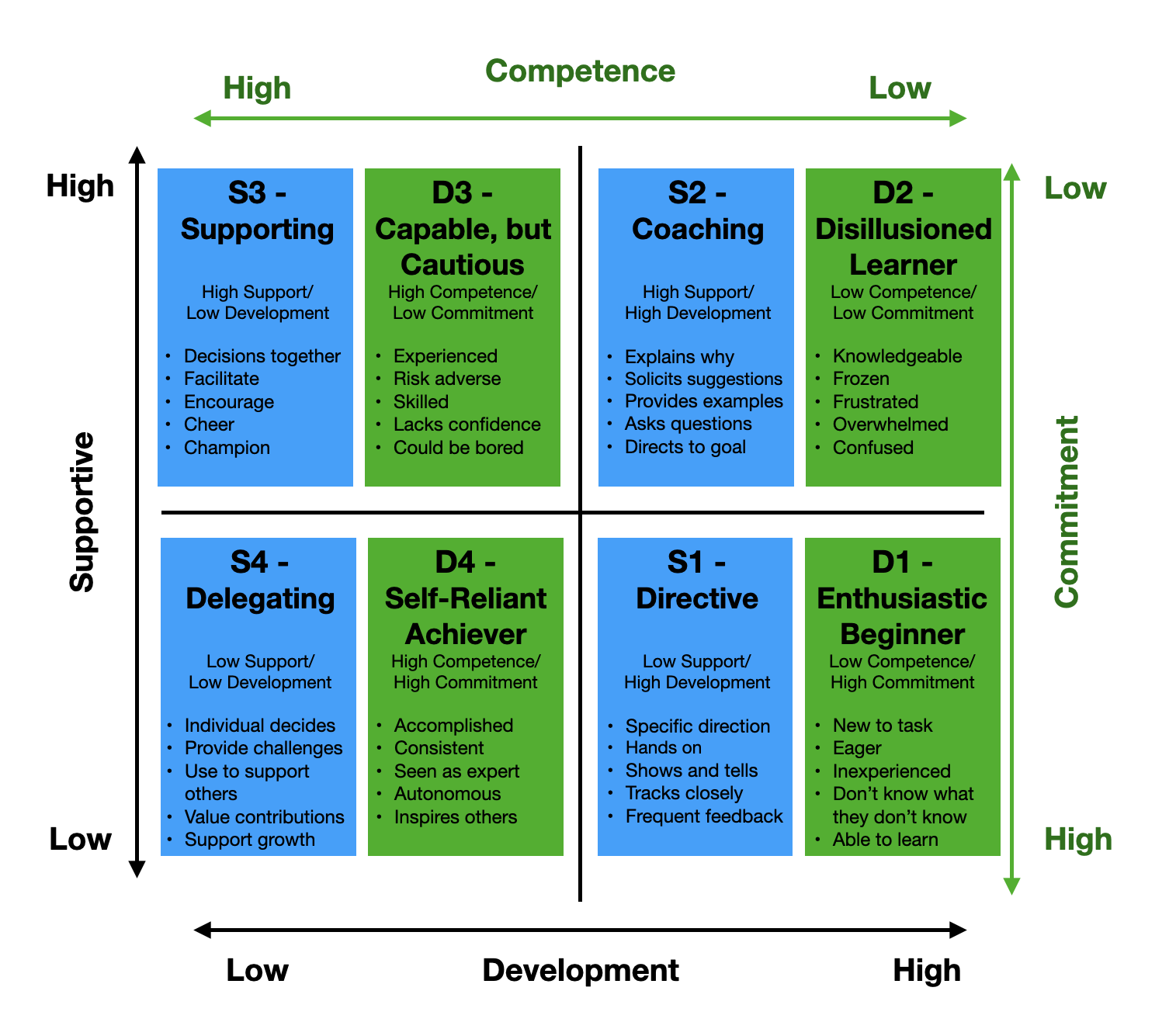Situational Leadership is Not Just Environmental; It Matches Leadership Support to Learner Needs
The idea of Situational Leadership almost seems like common sense. It feels practical on the surface and something everyone should do at some level — right? Yet, as you likely know, it is not common practice to have a leader that can apply different support and leadership styles in a way that you need it, when you need it most. Based on information from the Ken Blanchard Companies, more than 54% of leaders state that they only use one style of leadership for their team. That would result in, at least 50% of the time, team members being lead in a mismatched way for the context they find themselves in.
One of the things that utilizing the framework of situational leadership offers is the creation of a common language for both leaders and learners alike. You are matching a leadership style to the assessed situational awareness (or developmental needs) of the Individual. Most of the images for these will depict the leadership style on a grid, with the axis labeled with developmental (horizontal) and supportive (vertical). These coordinate with a more linear approach to the developmental needs, within the SLII model. However, an inverse grid set of axes can be applied to align the grid for matching the leadership style with the developmental needs. I have illustrated this below with some fundamental definitions of both the leader and learner assignments.
The Situational Leadership II model designates D1 – D4 for the developmental needs and S1 – S4 for the matching leadership style.
S1 – Directing matches – D1 – Low Competence and High Commitment (The Enthusiastic Beginner)
S2 — Coaching matches – D2 – Low (relative) Competence and Low Commitment (Disillusioned Learner)
S3 — Supporting matches – D3 – High Competence and Low (relative) Commitment (Capable but Cautious)
S4 — Delegating matches – D4 – High Competence and High Commitment (Self-Reliant Achiever)
I think it is important to keep all of these relative to the learner and your culture. Terms like ‘disillusioned learner’ could pigeonhole someone in a negative or inaccurate way for whom that person is. I purposely called out (relative) for competence or commitment for a few of the descriptions above. A D2 employee may have a solid history with the company, but is being exposed to a new process, environment, or experience and is (relatively) low in competence related to what they are being introduced to. That should not take away from what they have and continue to do well in other areas. The same can be said for a D3 employee, where their commitment on the grid shows as ‘low’. They are likely as ‘committed’ and an employee in the overall culture as they were the day before. But, relative to a new situation, they may become cautious or anxious because the process is new to them. This is where the term ‘situational leadership’ becomes so important. How you direct or support is relative to the situation or context of that specific timeframe for that specific individual.
Matching styles to needs
It cannot be overstated enough that matching the leadership style to the developmental needs is what this approach is all about. Too much direction can be just as bad as too little. Having the framework above to determine the style you need to match to allow you to be more purposely and intentional in your leadership and creates the appropriate conversations, feedback, and direction for the learner.
Mismatched leadership styles can lead to common feelings of anger, frustration, fear, disappointment, abandonment, over-managed, under-supported, confusion, and disillusionment.
Well-matched and applied leadership styles result in team members who describe themselves as happy, supported, productive, enthusiastic, confident — even in new situations, excitement, encouraged, and engaged.
As you begin to think about why matching styles is important, consider how the employee might begin to feel. Too much directing in a competent and confident individual will lead to frustration and a feeling of being micromanaged. Too little direction for someone experiencing a project or set of circumstances that is new to them can feel like being left alone to figure it out on their own, also resulting in the frustration and a fear of failing.
Effectiveness
Being effective as a leader essentially lands back at the core of all we do, and that is setting clear expectations and delivering positive results. Goal or expectation setting at the beginning of any new ‘season’ of work allows you and those you serve to connect and agree on what needs to be completed, as well as what the outcome should look like. This is also the opportunity to assess the individual for what developmental level they are at for this specific goal or desired outcome. This is how accountability is born, fostered, and championed.
There are numerous elements that manifest in situational leadership that directly apply to other fundamental leadership principles. The basis for accountability lies within situational leadership, as shown above. All the concepts from the One Minute Manager are also founded in matching leadership to the needs of the employee. In our next article, we will dive in a little deeper on that element specifically as we look at what situational leadership looks like in action.
Leading with this situational mindset begins with connecting with your team members and assessing and understanding their level of experience and comfort with a project, process, or context they are working within. That will assist in determining the style of leadership you need to apply – directing, coaching, supporting, or delegating for each individual and set of circumstances. Learners are evaluated on their relative competency and commitment as it relates to that set of circumstances. Connecting those two pieces together will build positive engagement and strong connections between you and your team.
How can you ensure you are always matching the correct leadership style to the needs of your individual team members?
Join other retail leaders in continuing their development journey with Effective Retail Leader.com. SUBSCRIBE today to receive leadership tips directly to your inbox and monthly newsletters that provide many tools to help further develop your leadership skills. JOIN NOW!
Photo by Katarina Šikuljak on Unsplash



